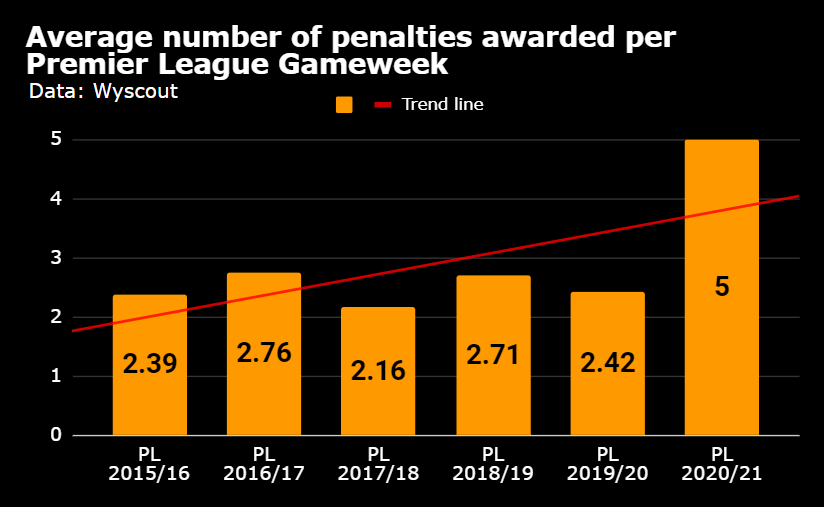Hello everyone, welcome to the third Marginal Pains newsletter. Thanks to those of you who have already subscribed.
It’s David here, and I am kicking Sam (sadly, not in real life) out of the hot seat so I can take centre stage and talk to you about penalties.
On Sunday morning, I pointed out that the Premier League had already produced seven more penalties than the Championship, despite playing 62 games fewer. Since that tweet, the difference in the number of games has reduced slightly as a result of the fixtures played on Sunday and Monday, yet, that penalty difference between England’s top two tiers does remain pretty remarkable.
At its current rate, the Premier League is seeing an average of five penalties awarded per game week. To give you an indication of just how high that number is, below is that Gameweek average alongside the Gameweek averages for each of the previous five Premier League campaigns.
The Championship is currently averaging around 3.29 penalties per Gameweek, which is the highest in that division for some years, but notably less than what we’re seeing in the Premier League.
The obvious difference between these two divisions is one uses the Video Assistant Referee (VAR) system, and the other does not.
The 2019/20 campaign was the first where the technology was utilised in the Premier League, but it debuted with varying degrees of success. As a result in the summer, some adjustment and adaptions were made in an attempt to improve the implementation of the system this season.
One of the key changes was an increase in the use of the Referee Review Area (RRA), which now has more of a say on subjective decisions in the three key areas - goals, red cards and of course, penalties.
It’s why we now see every decision scrutinised across multiple different speeds and camera angles to an almost wearisome degree.
The consequence of doing this is that we’re often seeing that the VAR/RRA find more evidence to support awarding a penalty, rather than denying or overturning it. Notably, just one penalty decision has been overturned by VAR so far this season.
Marginal Pains is brought to you in partnership with MANSCAPED™, the very best out there in terms of men’s below-the-waist grooming. MANSCAPED has created precision-engineered tools for your family jewels to make sure you have an unrivalled grooming experience.
As a Marginal Pains reader, you can get 20% Off and Free Shipping with the code MARGINAL20 at Manscaped.com.
If you want to support us, then support them - Your balls will thank you™
Now, in my humble opinion, there’s already a case to argue that a penalty is too harsh of a punishment for some of the offences we see on a weekly basis on the Premier League.
Take Fabinho’s foul on Oli McBurnie during the clash between Liverpool and Sheffield United last weekend. Should a debatable trip on a player who is situated 18 yards from goal and facing the opposite direction result in him being awarded an unopposed shot at goal from 12 yards out?
This is more so the case for infringements that happen wide of the goalmouth where shooting angles are usually tight. To highlight this, see the below (source: datagenetics).
Theoretically, as things are right now, an attacker could shape up to shoot from the position highlighted in the image to the left. The angle isn’t favourable and there’s likely to be a number of defenders nearby closing him down.
As a result, the prospects of this effort leading to a goal will likely be slim. Yet, that shot could hit the arm of a nearby defender and then be awarded as a penalty. The chance is then noticeably upgraded from a low-quality one to a high one.
This theoretical handball may not have been awarded in the days before VAR, yet it almost certainly would be now.
Whilst it’s unlikely that we’re going to see a rate of five penalties a Gameweek being maintained across the entirety of the season, the evidence does suggest that there does seem to be a correlation between the use of VAR/RRA and an increase in spot-kicks awarded.
As a result, it may be time to consider some radical changes in how we award penalties in the coming years within top tier football. Why? Well, let me try and explain.
I often label football a low scoring sport, which does raise a few eyebrows, and I get it. After all, more than half of the Premier League’s fixtures last season produced three or more goals.
However, in the context of other sports such as basketball, rugby, cricket, American football and so on, our game doesn’t tend to have many scoring moments across the course of 90 minutes. As a result, goals tend to prove more valuable in football than they do in some of those above-mentioned sports.
Notably, only 40% of Premier League results were settled by more than a single goal margin last season, meaning around 60% of results were determined within a single goal margin.
You can now financially support Marginal Pains over on Buy Me A Coffee.
Now consider this, in nearly all Expected Goal (xG) models, a penalty carries a value of around 0.76 - that’s high. In a non-sophisticated way, you could argue that it tells us that every three in four penalties are scored.
Therefore if we are seeing more penalties awarded, then we’re likely going to see more fixtures settled as a direct result of them.
Is that really what we want? If like me, you don’t, then how do we overcome it?
Well, there are different ways to approach it. One way could be reforming the traditional penalty box design. Perhaps making the area smaller, or even doing away with it all together and implementing something new?
Someone suggested a field hockey-like penalty area to me recently on Twitter, and I didn’t hate the idea. After all, we see that semi-circle design implemented in five-a-side football.
If that’s deemed too drastic, could we instead see different outcomes depending on the location an infringement is made within the penalty area? More in-direct freekicks rather than spot-kicks? Remove the penalty spot and take penalties from the spot in which the foul was committed?
Football does feel like it’s on the cusp of some drastic changes across many different areas, and perhaps the way in which we award penalties could and should be one of the biggest changes we see next.
It would be great to hear whether you agree with the above and if you have your own thoughts on how the current system could be improved? Or if you don’t agree, why?
Hit us up on @DAHughes_ and @SamMcGuire90.
You’ve heard of pass the pod, right? Well, let’s do pass the article. If you know someone who might like this, please do share.
Subscribe now and you won’t even have to search for these articles online, they’ll just appear in your inbox.







